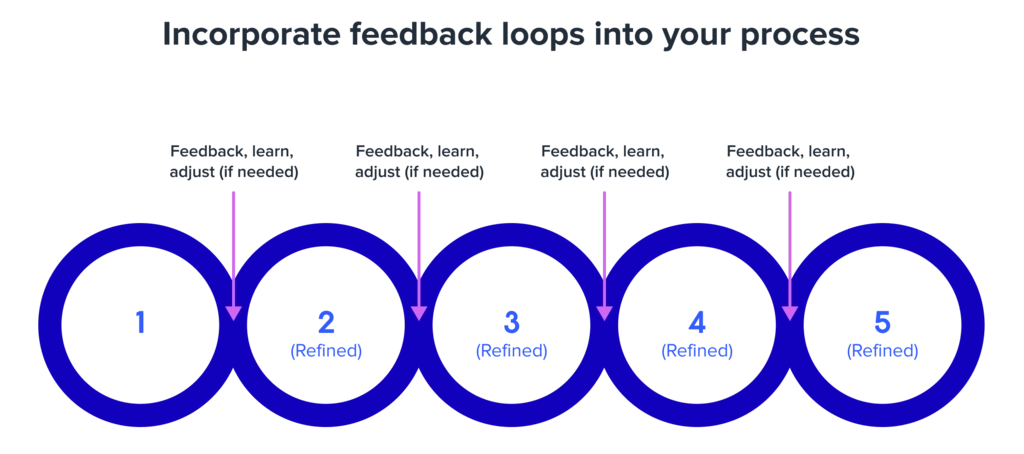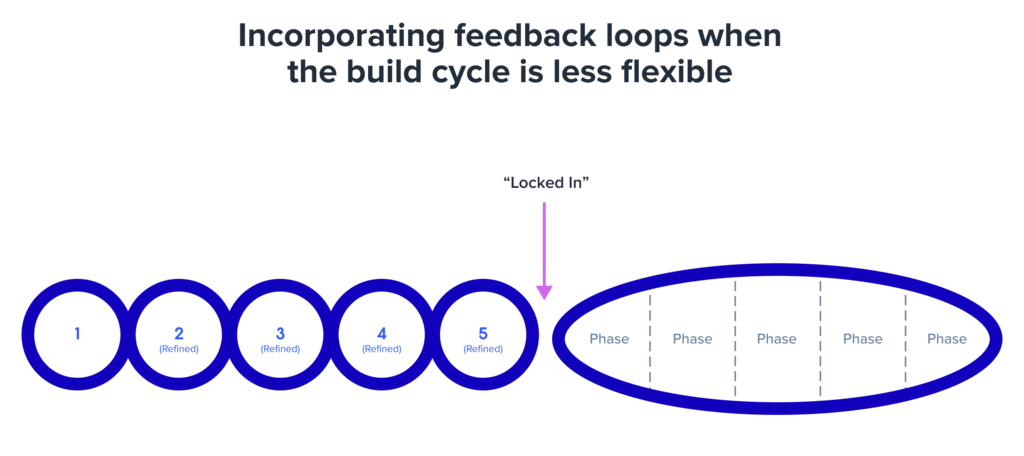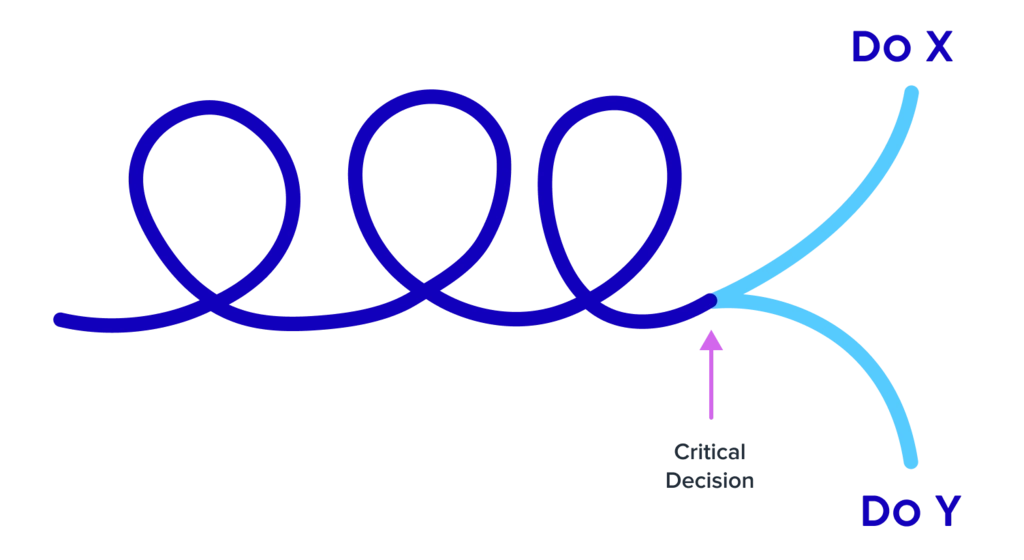
In this guide
How to build customer-centric products with fast feedback loops
How to build customer-centric products with fast feedback loops

Product managers play a critical role in the success of companies large and small, across all industries. Balancing business priorities, customer needs, and technical challenges in the face of tight deadlines, they have a lot on their plate—and a lot on the line.
Making this role even more challenging, today’s product development moves at an increasingly rapid pace. To launch products that customers love, fast, product managers must be strategic about using customer feedback to challenge their product ideas at every stage of the product development lifecycle.
How? By refining their understanding of three, core questions:
- Who is your customer?
- What is their problem?
- What’s the best solution I can build for them?
In this guide, we’ll take you through the benefits of fast feedback loops and how you can use them to inform your product decisions. Find out how to confidently design, build, and iterate products that meet your customers’ needs.
“Creating great products is all about two things: 1. uncovering core user needs and 2. meeting them. If you don’t have some evidence-driven approach for the first part, your ability to consistently deliver on the second will suffer.”
Kenton Kivestu
CEO and Founder, RocketBlocks
You must learn (and relearn) your customers

Before we dive into the value of fast feedback loops, it’s important to understand why they’re so important. Some might even say now more than ever before. While it may be a pandemic that’s changed life as we know it today, it could be something different tomorrow.
The impact change has on your business cannot be understated. Often, product managers are left feeling the brunt of this. You’re expected to understand who your customer is, what they want, why they need it, all in parallel with executing everyday business priorities.
To stay on top of changing customer expectations, integrate their feedback whenever you can.
If you feel sure you already know your customer, it's time to check again. Even if you’ve collected their feedback in the past it’s critical to be in a continuous state of learning because your customers’ behaviors and expectations evolve in ways you can't always predict.
This may sound overwhelming, especially if you’ve already built your product roadmap for the foreseeable future. That’s ok. The process of learning about your customers can be incremental and continuous. You don’t have to conduct time-consuming, in-depth research to learn something new about them. And you don’t want to skimp on learning. There’s nothing worse than building a new product or feature that nobody wants or needs.
And that’s where fast feedback loops come in handy.
Understanding fast feedback loops

At the core, a feedback loop is a method for collecting feedback from your customers that can be quickly integrated into your existing product development process.

The concept is simple. Whatever processes you follow—be it double diamond, agile, design thinking, or something else—fast feedback loops are checkpoints where you test your concepts and ideas or progress with your customers. Sometimes the insight will be small. Sometimes it’ll be really big, but one thing is always true—getting feedback early and often leads to greater impact. And, almost counter-intuitively, implementing multiple feedback loops will actually result in a shorter overall cycle time.
Innovate fasterWith actionable user feedback, you can align on defensible decisions more quickly | Reduce risk and costAvoid building the wrong products or features by validating ideas and concepts with customers | Adoption and usageBuild products that are truly customer-centric so customer needs are met the first time |
No matter how many weeks you plan and years of experience you have designing products, there will always be baked-in assumptions about what’s best and hidden nuances you may never consider. By challenging your assumptions and uncovering potential pitfalls early, you’ll avoid expensive and frustrating rework later.
Feedback loops within rigid processes
Sometimes, in industries like Fintech, for example, rigid build processes are put in place to avoid risk. In these risk-averse environments, you and your developers are locked in and can’t change course in the build phase. Even in scenarios like these, there are still ways to get feedback within the overall process.

In these cases, it’s important to implement feedback loops during the design phase so you can ensure you’re on the right track early. However, feedback loops don’t need to stop there. Even if you’re locked in during the build phase, you can still get incremental feedback throughout the process. While you won’t be implementing these changes in real-time, or pivoting as a result of feedback, you’ll still be equipped with the feedback you need to adjust post-launch. You’ll be better able to set expectations with stakeholders prior to launching and be prepared to address concerns before they arise in the wild.
Now that you have a clearer understanding of where feedback cycles can fit into development, let’s take a look at some more specific examples of how they can be used.
Feedback loops in problem and solution spaces

When you’re thinking about leveraging feedback loops, it’s helpful to consider not only where in your development cycle you are, but also what you’re trying to understand. One way to simplify this is to think about them in terms of problem and solution spaces.
In the problem space, you’re looking to determine if there is, in fact, a problem your customers have. You’ll need to understand and clearly define it. Then in the solution space, you’ll work through different ideas to best solve a real problem that you’ve identified.
- Problem space: uncover unknowns, avoid time-consuming rework, identify a problem
- Solution space: dig deeper, connect the dots, build the right thing
In both spaces, the work boils down to two things: challenge your assumptions and refine your understanding to clarify a path forward.
“I think one of the unsung heroes of doing feedback loops is that you uncover unknowns early in the process.”
Brian Pohuski
Senior Product Manager, UserTesting
Problem space
The primary goal of using feedback loops in a problem space is to dig into challenges that you’re seeing customers having. With every cycle, the picture you’re painting of what it's like to be your customer should get clearer and clearer.
One way to approach a feedback loop in the problem space is to employ the concept of five whys. Five whys is an iterative approach to uncovering the root of a problem. It encourages you to dig deeper into surface-level problems to uncover the underlying issue. You do this by asking someone to explain why something is happening five times in sequence—allowing you to get deeper information each time. After you’ve generated an answer for the first “why”, ask "why" four more times in succession. Each time, frame the question in response to the answer you've just recorded.
Solution space
The solution space is where products and prototypes are built. And typically, it’s where product managers like to spend most of their time. If that’s not the case for you, good. Products exist to solve problems. Therefore, spending more time in the problem space isn’t a bad thing. After all, it’s impossible to build the right thing without a complete understanding of the problem you’re trying to solve.
Nonetheless, feedback loops should not be forgotten or abandoned in the solution space. Once your problem space is clear, you need to shift focus to validating and prioritizing in the solution space.
Here, you can leverage feedback loops to validate your solutions to problems and prioritize which are most important to your customers. Do this by iteratively testing your prototypes and adjusting according to the sentiments of your customers.
Next, let’s dive into how you really get fast feedback with feedback loops.
How to use fast feedback loops for product development

In general, a feedback loop should have three primary stages. This isn’t necessarily a rigid process. Think of what’s to come as a framework. To be clear, you can (and should) customize the framework to fit your own product development process as best fits your needs.
Stage 1: capture and store feedback
During this first stage, it’s your job to capture and store feedback. This feedback can come from anywhere. Perhaps you’ve got access to market research, or internal stakeholders have passed along some valuable information. Maybe you’ve collected everyday observations from you and your peers or you’ve conducted interviews, user tests, surveys, the list goes on.
The point is, before you can start actually doing any product design work, you need to make sure that all of your data is captured, stored, and organized so that you can analyze it.
Pro tip: affinity diagrams are a great way to organize user feedback. Check out our template made in partnership with InVision.
Stage 2: analyze feedback
Now that you have all of your feedback and data points organized in a consumable way, it’s time to analyze the information and challenge your assumptions—with an emphasis on challenging your assumptions. Don’t consider all of the opinions and observations you’ve collected to be fact. You still need to identify trends, patterns, and anomalies in your data.
Once you’ve taken all the information into account, synthesize it down to one (or a few) problems. These will be the problems you work through to produce product solutions.
Stage 3: make decisions based on feedback
When making a decision based on feedback, your goal is not to build a polished solution. What you’re really trying to do is build a design or prototype that’s challenging your previous assumptions and purpose-designed for your customer problem.
You won’t be able to solve all of your customers’ problems in one go. If you think you can, odds are you haven’t fully distilled your information into small, actionable insights. Customer problems are plentiful and complex, but your goal is to build something fast and light that solves a major problem. Remember, fast feedback loops allow you to iterate quickly, so don’t be afraid to fail fast and optimize your framework for learning.
In this phase, rather than getting to a perfectly polished state right out of the gate, you’ll want to continuously test and adjust your designs and prototypes until you believe it’s the right time to build the actual minimal viable product (MVP).
Continue to test your prototypes with customers until your feedback loop is no longer providing you actionable feedback. Alternatively, if you’re working against a deadline, continue to test until it’s time to move to the build phase of your product. This way, you’re as close to a customer-centric solution as is possible.
Bonus stage 4: collect continuous feedback post-launch
Feedback loops provide the most value prior to launching your actual product, therefore your feedback loop could (and should) kickstart again after stage three until you’ve nailed down a prototype that customers agree meets their expectations.
Once you’ve done that, it’s time to build and launch your product. That doesn’t mean collecting feedback is over. In this scenario, you want to continue to collect feedback on your product until you reach an inflection point.

An inflection point is a moment where you have to make the most critical decision about your product. It’s where you have to decide whether you go down one path or another because both cannot coincide. It’s likely that both paths will have advantages and disadvantages and accomplish the same objective in different ways.
At this time, you’ll want to implement another feedback loop that helps you identify the possible paths to solve a single problem. Your learnings should snowball here until you have one ball that’s seemingly larger and more powerful than the other. This will likely be the solution you go with or at least pitch to relevant stakeholders.
Just because you’ve launched your product in the market does not mean your project is complete. Remember, customer expectations are changing constantly and customer needs are evolving with the environments around them. You’d be remiss to not continuously check to see if your product is still meeting expectations.
Arriving at a customer-centric product

We said it earlier, but it’s worth repeating: implementing fast feedback loops in your product development process is not linear. In reality, there’s never a wrong time to better understand your customers’ needs and challenge your assumptions about them. Inspiration for your next product iteration can come up anywhere and after any implemented feedback loop. That’s why building a truly customer-centric product rarely happens the first time.
If in the course of development you get feedback that creates the opportunity to pivot and change direction, or creates an offshoot project for another team to pursue, these are moments to regroup and decide how to proceed. Let the information you gather from feedback loops be your guiding light and ensure that all the work, time, and resources you put into creating newer and better products line up with what your customers want.
Watch a demo
See how easy it is to get fast feedback on a website, prototype, design, or more in this demo.


